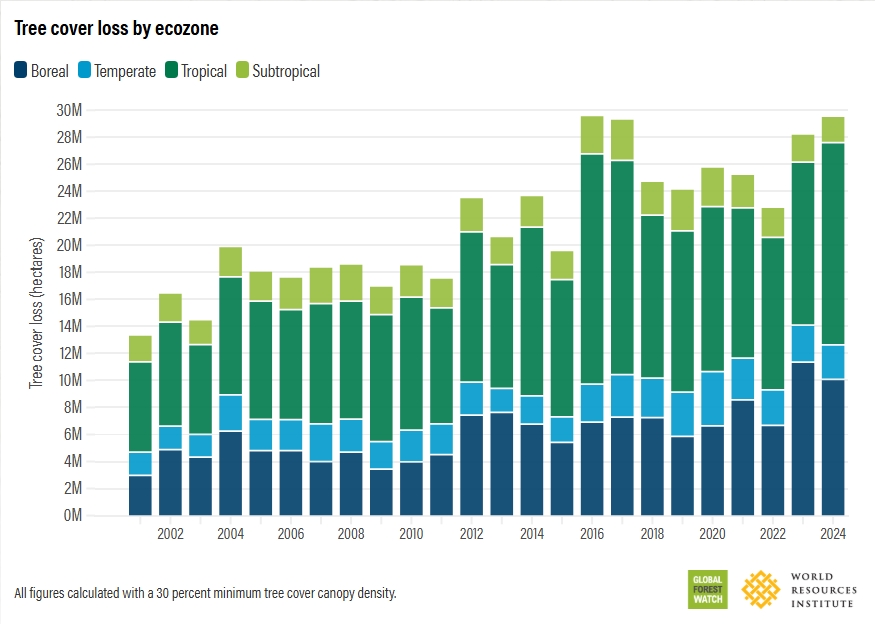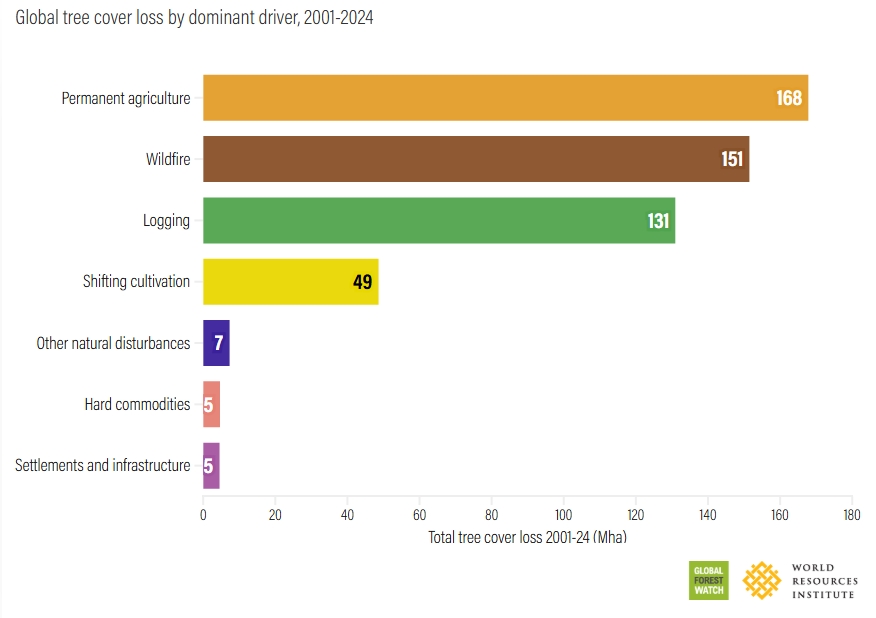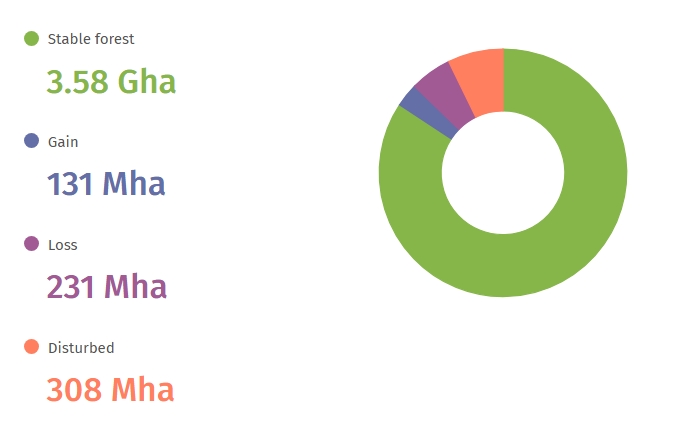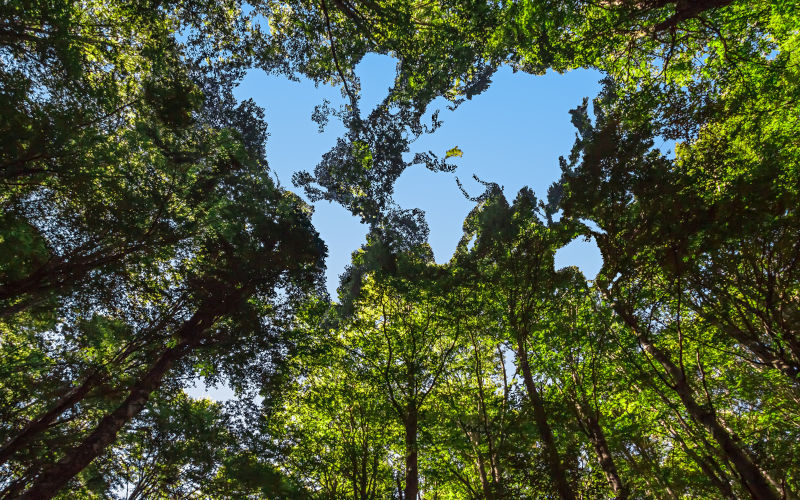The Earth uncloaked – A catastrophe in slow motion
October 10, 2025
Woodman, spare that tree!
Touch not a single bough!
In youth it sheltered me,
And I’ll protect it now. – GP Morris 1837
From one side of the globe to the other, the ring of axe, the snarl of chainsaw and the roar of flame are sounding the knell for the world’s forests, as the green Earth turns scarred, charred and desolate.
Originally, forests cloaked 57% of the land. Today their area is 31%. A total of 420 million hectares of forest have been lost since 1990 and 10 million more are now lost each year.
Rates of deforestation are worst in Russia, Brazil, Canada, the US and China. But the trend is not all one way: in Scandinavia, for example, the process of forest loss is being reversed with new plantings and restoration. Deforestation (total loss) is not the only threat: thinning for timber, inroads by farming, fragmentation by roads and towns, pest invasions, wildfires and climate change also take a heavy toll of what remains. Forest loss is a primary driver of the 6th extinction.

Together, these forces, propelled by insatiable human demands, are reducing the last remaining intact forests on Earth. Between 2000 and 2020, the area of intact forest fell by 1.55 million sq kms – a span the size of France, Germany and Spain combined.
Ominously, over this period, the annual rate of forest loss sped up, from an average of 7.1 million hectares between 2000-2013 to 9 million hectares from 2013-2020. The uncloaking of the Earth is closely observed by the unblinking eyes of a thousand satellites orbiting the planet.
In Brazil, the Amazon rainforest has dwindled in extent by 17%, losing more than 800 million trees in the last two decades. While the plight of the Amazon is notorious, the fact that Brazil has already destroyed 85% of its huge eastern tropical rainforest, the Mata Atlantica, and fragmented the remains, is less well-known. The removal of the Brazilian forests has profound consequences for the drying of the entire South American continent, and for global climate change through the gradual destruction of the largest carbon sink on the planet.
Another vast forest, vital to the Earth’s life support system but under savage attack, is the Northern Boreal Forest, which spans Canada, the US, Scandinavia and Russia, and is falling before a combined assault from logging, farming, mining and energy extraction, urban spread, climate change and the increased wildfires, pests and diseases which follow extensive tree felling.

Figure 1. Causes of global tree cover loss 2021-24. Source: Global Forest Watch, 2025.
Despite its green image, the wholesale destruction of the world’s forests was led by Europe. Over 6000 years, with the invention of bronze and iron axes and spread of agriculture, it gathered pace. By 1800, half of its wooded area was gone. There has been little let-up in recent times, with Europe today continuing to remove trees and having next to no primary forest left.
Today, the chief villains in global deforestation are not farmers or even miners, but the giant food corporations and their agribusiness offshoots, currently shredding the world’s forests and their wildlife so as to produce more beef, soybeans, chocolate and palm oil for the unhealthy industrial diets they have marketed so successfully to urban consumers.
Corporate food is a major factor in the removal of the rainforests of Southeast Asia, which has lost half its trees since logging began. In the first two decades of the C21st, the region lost more than 610,00 sq kms, an area larger than Thailand. The countries most affected are Indonesia, Malaysia and the island of Borneo and the main cause is clearing for industrial palm oil production. The orangutan, Javan rhino, and Sumatran tiger are among the wildlife critically endangered by the destruction.
A balancing act
The world forest scene is not one of unrelieved despair, as large areas are being replanted by eager volunteers or regenerate naturally every year, offsetting some of the losses. The following table shows how the gains compared with the losses between 2000-2020. All told, 101 million hectares more were lost than gained.

Figure 2. Changing tree cover 2000-2020. Source: Global Forest Watch, 2025.
Both Russia (+37mha/yr) and Canada (+17mha/yr) successfully replanted large areas of forest during this period – but not nearly as much as they removed.
Of huge significance is the growing area of disturbed forest, which is subject to selective logging, fragmentation by roads and farms, wildfire and pests or diseases. Disturbance has been found by scientists to convert forest from a carbon absorber to a net emitter – and thus, an accelerator of climate change. It is estimated that presently less than 30% of the world’s remaining forest area is undisturbed.
Climate impact
There is now ominous evidence from around the world that the Earth’s depleted forests are becoming a major contributor to Hothouse Earth – in a vicious feedback loop that few expected.
Tropical forest loss alone releases nearly five billion tons of carbon dioxide into the atmosphere every year, which is equivalent to 10% of annual human emissions. This means that tropical forests now add as much carbon to the atmosphere as all industry worldwide.
The Amazon, once one of the world’s most biologically diverse ecosystems and important carbon sinks, has been found by science to emit more CO2 than it now absorbs as a result of deforestation, fragmentation, wildfires and climate change.
Between 2001 and 2024, according to Global Forest Watch, the world’s forests emitted 9.15 billion tonnes of carbon, and removed -14.4 billion tonnes a year. This represents a net sink (reduction) of -5.29 billion tonnes of atmospheric carbon a year.
If all forests located outside agricultural and urban areas were allowed to recover globally, they would have the potential to capture 226 gigatons of carbon, says the World Economic Forum. This would mop up almost a third of humanity’s carbon emissions.
Forest conservation
Forests deliver profound benefits to humanity, including
- Much of the oxygen we breathe.
- Trapping and storing carbon, reducing global warming.
- Bringing rain and feeding the global water cycle.
- Storing fresh water.
- Protecting the soil and increasing fertility.
- Vital resources for humans, livestock and wild animals.
As a result, forest protection is being actively promoted worldwide. Here are some salient initiatives:
- Trillion Trees Campaign: aims to plant and restore one trillion trees worldwide. Afforestation initiatives accelerated in 2025 in nations including Brazil, Kenya and India.
- UN Strategic Plan for Forests: aims by 2030 to grow the world’s forest area by 3%, or 120 million hectares, more than twice the size of France.
- International Tree Foundation
- Trees for the Future
- Global Tree Initiative
- The Bonn Challenge
- Plant a Billion Trees – The Nature Conservancy.
- World agroforestry - CIFOR
- The Great Green Wall of China.
- The Great Green Wall of Africa
Almost every country has a tree-planting program, some of them highly successful – notably those in India, Ethiopia, Turkey and Costa Rica. But these efforts are still being outrun by the industrial logging giants: Russia, Brazil, Canada, the US and China. And many countries have a bet each way by promoting tree planting to the public while quietly and deceptively encouraging their logging and land clearing sectors.
Deforestation is a global catastrophe in slow motion. Despite the good intentions of many, it is still accelerating, as humans continue to gnaw, like termites, at the very foundations of the Earth’s life support system – and their own future.
The views expressed in this article may or may not reflect those of Pearls and Irritations.
